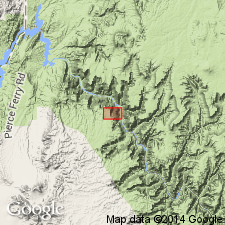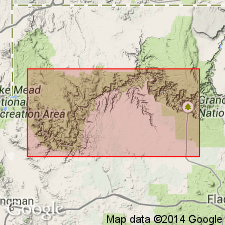
- Usage in publication:
-
- Surprise Canyon Formation*
- Modifications:
-
- Named
- Dominant lithology:
-
- Sandstone
- Conglomerate
- Limestone
- Siltstone
- AAPG geologic province:
-
- Plateau sedimentary province
Summary:
Named for Surprise Canyon, tributary to Colorado River, Amos Point quad, Mohave Co, AZ, Plateau sedimentary province. Type section measured about 1.5 km southeast of Bat Tower viewpoint (Long 113 deg 48' N; Lat 36 deg), 1.6 km west of Colorado River and 2.4 km southwest of Tincanebits Canyon. Recognized in Grand Canyon and part of Marble Canyon areas. Previously considered part of Redwall Limestone, or part of Watahomigi Formation, or an unnamed valley-fill sequence between Redwall and Watahomigi, depending on locality. Divisible into: 1) basal unit of nonmarine cobble, pebble (chiefly white, yellow, red chert, limestone from Redwall in matrix of poorly sorted, subround, coarse-grained quartz sand with siliceous, calcareous, ferruginous cement) conglomerate, dark-gray to red-brown, medium-to coarse-grained, locally cross-stratified calcareous sandstone, and medium- to fine-grained siltstone; 2) upper unit of marine, brown to yellow gray, coarse-grained, fossiliferous, cliff- and ledge-forming limestone, and red-brown, thin-bedded, ripple laminated, slope-forming sandstone and siltstone. Is 91 m thick at type; 122 m thick at Quartermaster Canyon. Is a valley-fill sequence cut into and through Horseshoe Mesa Member to Mooney Falls Member of Redwall. Unconformably overlain by Watahomigi Formation. Fossils listed. Late Mississippian or Chesterian age, and locally also Early Pennsylvanian? or Morrowan age. Cross sections.
Source: GNU records (USGS DDS-6; Denver GNULEX).

- Usage in publication:
-
- Surprise Canyon Formation*
- Modifications:
-
- Age modified
- Biostratigraphic dating
- AAPG geologic province:
-
- Plateau sedimentary province
Summary:
Is formation of mixed carbonate and clastic sediments that fills deep channels and cavities in the uppermost part of the Redwall Limestone (Mississippian). Conodonts of the upper Chesterian (Upper Mississippian) ADETOGNATHUS UNICORNIS Zone were recovered from marine limestones of the Surprise Canyon Formation in western and central Grand Canyon, Mohave and Coconino Cos, AZ (Plateau sedimentary province). Basal limestones of the overlying Watahomigi Formation contain conodonts of the slightly younger RHACHISTOGNATHUS MURICATUS/ADETOGNATHUS LAUTUS Zone, which indicate either a latest Chesterian or an earliest Pennsylvanian age. Recovery of the Pennsylvanian species DECLINOGNATHODUS NODULIFERUS seventeen meters above the base of the Watahomigi in Quartermaster Canyon suggests that the Mississippian-Pennsylvanian boundary occurs within the lower units of the Watahomigi Formation of the Supai Group. Thus, the age of the Surprise Canyon Formation is modified from Late Mississippian and Early Pennsylvanian(?) as per Billingsley and Beus (1985) to only late Chesterian, Late Mississippian.
Source: GNU records (USGS DDS-6; Denver GNULEX).
For more information, please contact Nancy Stamm, Geologic Names Committee Secretary.
Asterisk (*) indicates published by U.S. Geological Survey authors.
"No current usage" (†) implies that a name has been abandoned or has fallen into disuse. Former usage and, if known, replacement name given in parentheses ( ).
Slash (/) indicates name conflicts with nomenclatural guidelines (CSN, 1933; ACSN, 1961, 1970; NACSN, 1983, 2005, 2021). May be explained within brackets ([ ]).

